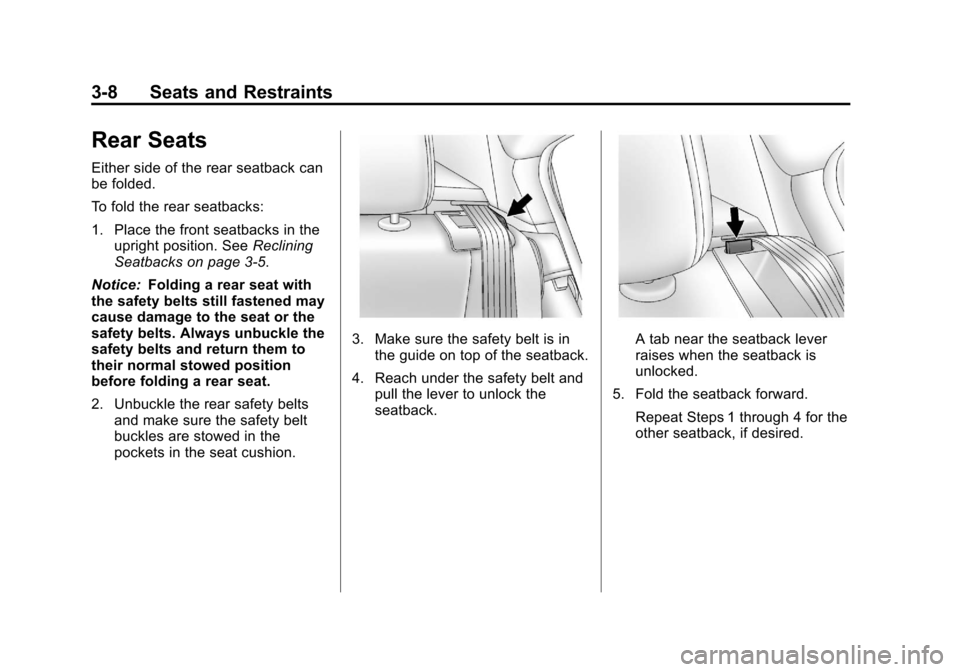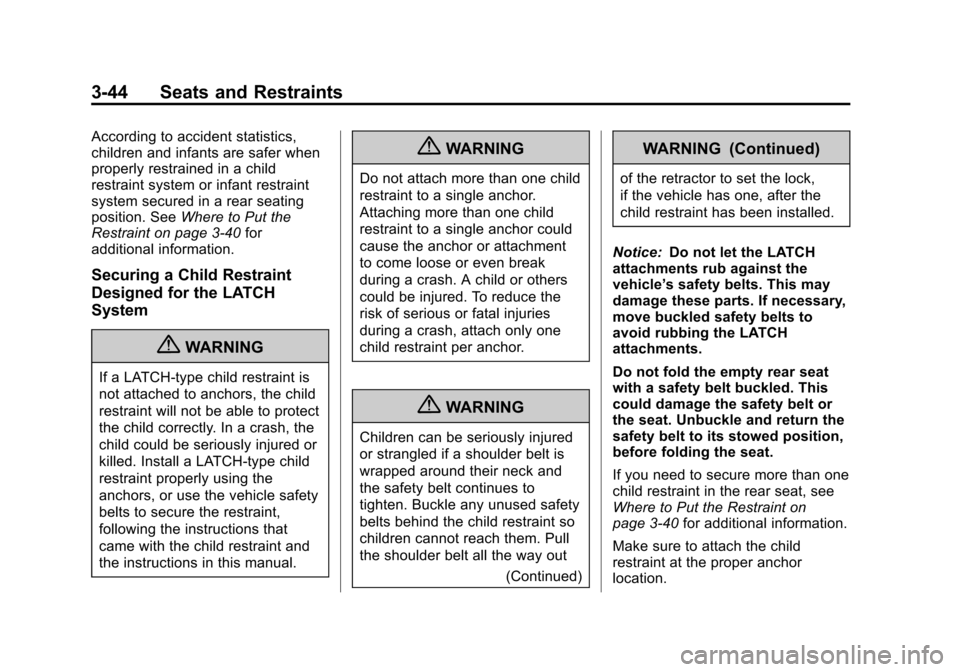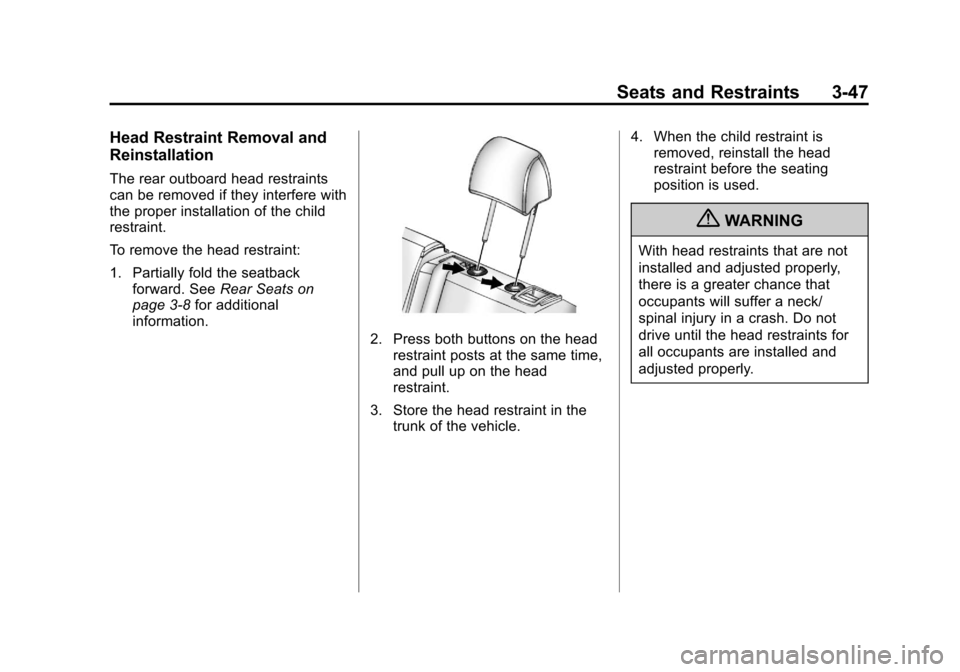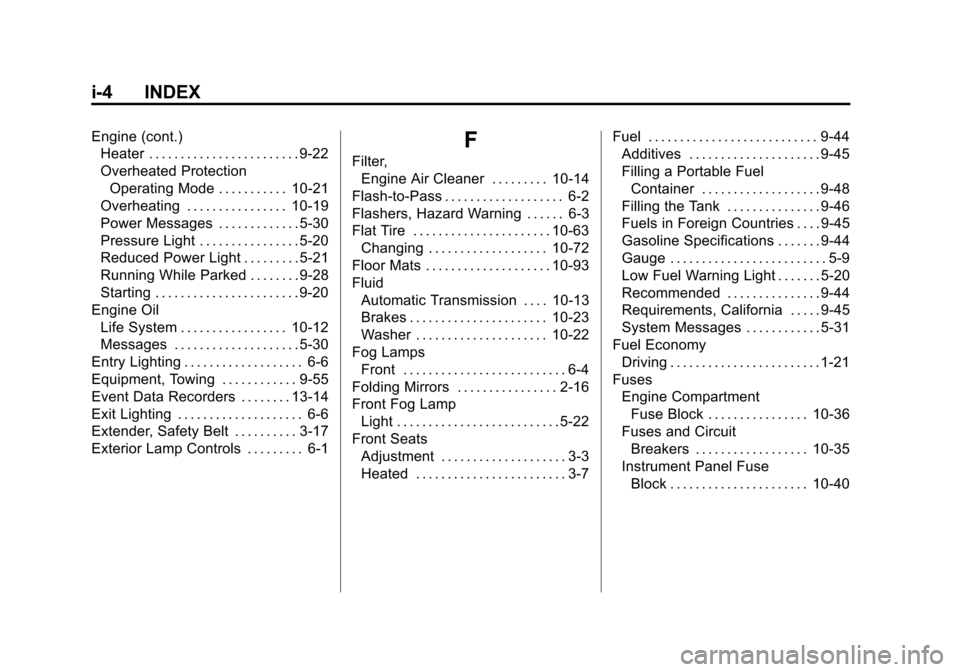2012 CHEVROLET CRUZE fold seats
[x] Cancel search: fold seatsPage 14 of 400

Black plate (8,1)Chevrolet Cruze Owner Manual - 2012
1-8 In Brief
Reclining Seatbacks
To recline the seatback:
1. Lift the lever.
2. Move the seatback to thedesired position, then release
the lever to lock the seatback
in place.
3. Push and pull on the seatback to make sure it is locked. To return the seatback to an
upright position:
1. Lift the lever fully without
applying pressure to the
seatback, and the seatback
returns to the upright position.
2. Push and pull on the seatback to make sure it is locked.
See Reclining Seatbacks on
page 3‑5.
Power Driver Seat
To adjust a power driver seat,
if equipped:
.Move the seat forward or
rearward by sliding the control
forward or rearward.
.Raise or lower the front part of
the seat cushion by moving the
front of the control up or down.
.Raise or lower the entire seat by
moving the rear of the control up
or down.
See Power Seat Adjustment on
page 3‑4.
Rear Seats
The rear seatbacks can be folded.
For detailed instructions, see Rear
Seats on page 3‑8.
Page 43 of 400

Black plate (13,1)Chevrolet Cruze Owner Manual - 2012
Keys, Doors, and Windows 2-13
Remote Trunk Release
To open the trunk from outside the
vehicle, press the
Vbutton on
the Remote Keyless Entry (RKE)
transmitter, or by pressing the touch
pad above the license plate when
the doors are unlocked. If the engine is running, the doors
must be unlocked. Vehicles with an
automatic transmission must be in
P (Park), vehicles with a manual
transmission must have the park
brake applied.
Emergency Trunk Release
Handle
Notice:
Do not use the
emergency trunk release handle
as a tie-down or anchor point
when securing items in the trunk
as it could damage the handle.
The emergency trunk release
handle is only intended to aid a
person trapped in a latched trunk,
enabling them to open the trunk
from the inside.
There is an emergency trunk
release handle located inside the
trunk on the trunk lid. The release
handle can be accessed by folding
the rear seatback. See Rear Seats
on page 3‑8. Pull the release handle
to open the trunk from the inside.
Page 60 of 400

Black plate (8,1)Chevrolet Cruze Owner Manual - 2012
3-8 Seats and Restraints
Rear Seats
Either side of the rear seatback can
be folded.
To fold the rear seatbacks:
1. Place the front seatbacks in theupright position. See Reclining
Seatbacks on page 3‑5.
Notice: Folding a rear seat with
the safety belts still fastened may
cause damage to the seat or the
safety belts. Always unbuckle the
safety belts and return them to
their normal stowed position
before folding a rear seat.
2. Unbuckle the rear safety belts and make sure the safety belt
buckles are stowed in the
pockets in the seat cushion.
3. Make sure the safety belt is inthe guide on top of the seatback.
4. Reach under the safety belt and pull the lever to unlock the
seatback.A tab near the seatback lever
raises when the seatback is
unlocked.
5. Fold the seatback forward. Repeat Steps 1 through 4 for the
other seatback, if desired.
Page 96 of 400

Black plate (44,1)Chevrolet Cruze Owner Manual - 2012
3-44 Seats and Restraints
According to accident statistics,
children and infants are safer when
properly restrained in a child
restraint system or infant restraint
system secured in a rear seating
position. SeeWhere to Put the
Restraint on page 3‑40 for
additional information.
Securing a Child Restraint
Designed for the LATCH
System
{WARNING
If a LATCH-type child restraint is
not attached to anchors, the child
restraint will not be able to protect
the child correctly. In a crash, the
child could be seriously injured or
killed. Install a LATCH-type child
restraint properly using the
anchors, or use the vehicle safety
belts to secure the restraint,
following the instructions that
came with the child restraint and
the instructions in this manual.
{WARNING
Do not attach more than one child
restraint to a single anchor.
Attaching more than one child
restraint to a single anchor could
cause the anchor or attachment
to come loose or even break
during a crash. A child or others
could be injured. To reduce the
risk of serious or fatal injuries
during a crash, attach only one
child restraint per anchor.
{WARNING
Children can be seriously injured
or strangled if a shoulder belt is
wrapped around their neck and
the safety belt continues to
tighten. Buckle any unused safety
belts behind the child restraint so
children cannot reach them. Pull
the shoulder belt all the way out
(Continued)
WARNING (Continued)
of the retractor to set the lock,
if the vehicle has one, after the
child restraint has been installed.
Notice: Do not let the LATCH
attachments rub against the
vehicle’ s safety belts. This may
damage these parts. If necessary,
move buckled safety belts to
avoid rubbing the LATCH
attachments.
Do not fold the empty rear seat
with a safety belt buckled. This
could damage the safety belt or
the seat. Unbuckle and return the
safety belt to its stowed position,
before folding the seat.
If you need to secure more than one
child restraint in the rear seat, see
Where to Put the Restraint on
page 3‑40 for additional information.
Make sure to attach the child
restraint at the proper anchor
location.
Page 99 of 400

Black plate (47,1)Chevrolet Cruze Owner Manual - 2012
Seats and Restraints 3-47
Head Restraint Removal and
Reinstallation
The rear outboard head restraints
can be removed if they interfere with
the proper installation of the child
restraint.
To remove the head restraint:
1. Partially fold the seatbackforward. See Rear Seats on
page 3‑8 for additional
information.
2. Press both buttons on the head restraint posts at the same time,
and pull up on the head
restraint.
3. Store the head restraint in the trunk of the vehicle. 4. When the child restraint is
removed, reinstall the head
restraint before the seating
position is used.
{WARNING
With head restraints that are not
installed and adjusted properly,
there is a greater chance that
occupants will suffer a neck/
spinal injury in a crash. Do not
drive until the head restraints for
all occupants are installed and
adjusted properly.
Page 212 of 400

Black plate (14,1)Chevrolet Cruze Owner Manual - 2012
9-14 Driving and Operating
The GVWR includes the weight
of the vehicle, all occupants,
fuel, and cargo. Never exceed
the GVWR for the vehicle, or the
Gross Axle Weight Rating
(GAWR) for either the front or
rear axle.
And, if you do have a heavy
load, you should spread it out.
See“Steps for Determining
Correct Load Limit” earlier in
this section.
{WARNING
Do not load the vehicle any
heavier than the Gross
Vehicle Weight Rating
(GVWR), or either the
maximum front or rear Gross
Axle Weight Rating (GAWR).
This can cause systems to
break and change the way the
vehicle handles.
(Continued)
WARNING (Continued)
This could cause loss of
control and a crash.
Overloading can also shorten
the life of the vehicle.
If you put things inside the
vehicle —like suitcases, tools,
packages, or anything else —
they will go as fast as the
vehicle goes. If you have to stop
or turn quickly, or if there is a
crash, they will keep going.
{WARNING
Things inside the vehicle can
strike and injure people in a
sudden stop or turn, or in
a crash.
.Put things in the cargo
area of the vehicle. In the
cargo area, put them as
(Continued)
WARNING (Continued) far forward as possible.
Try to spread the weight
evenly.
.Never stack heavier
things, like suitcases,
inside the vehicle so that
some of them are above
the tops of the seats.
.Do not leave an
unsecured child restraint
in the vehicle.
.Secure loose items in
the vehicle.
.Do not leave a seat folded
down unless needed.
Page 392 of 400

Black plate (4,1)Chevrolet Cruze Owner Manual - 2012
i-4 INDEX
Engine (cont.)Heater . . . . . . . . . . . . . . . . . . . . . . . . 9-22
Overheated Protection
Operating Mode . . . . . . . . . . . 10-21
Overheating . . . . . . . . . . . . . . . . 10-19
Power Messages . . . . . . . . . . . . . 5-30
Pressure Light . . . . . . . . . . . . . . . . 5-20
Reduced Power Light . . . . . . . . . 5-21
Running While Parked . . . . . . . . 9-28
Starting . . . . . . . . . . . . . . . . . . . . . . . 9-20
Engine Oil Life System . . . . . . . . . . . . . . . . . 10-12
Messages . . . . . . . . . . . . . . . . . . . . 5-30
Entry Lighting . . . . . . . . . . . . . . . . . . . 6-6
Equipment, Towing . . . . . . . . . . . . 9-55
Event Data Recorders . . . . . . . . 13-14
Exit Lighting . . . . . . . . . . . . . . . . . . . . 6-6
Extender, Safety Belt . . . . . . . . . . 3-17
Exterior Lamp Controls . . . . . . . . . 6-1F
Filter,
Engine Air Cleaner . . . . . . . . . 10-14
Flash-to-Pass . . . . . . . . . . . . . . . . . . . 6-2
Flashers, Hazard Warning . . . . . . 6-3
Flat Tire . . . . . . . . . . . . . . . . . . . . . . 10-63 Changing . . . . . . . . . . . . . . . . . . . 10-72
Floor Mats . . . . . . . . . . . . . . . . . . . . 10-93
Fluid Automatic Transmission . . . . 10-13
Brakes . . . . . . . . . . . . . . . . . . . . . . 10-23
Washer . . . . . . . . . . . . . . . . . . . . . 10-22
Fog Lamps Front . . . . . . . . . . . . . . . . . . . . . . . . . . 6-4
Folding Mirrors . . . . . . . . . . . . . . . . 2-16
Front Fog Lamp Light . . . . . . . . . . . . . . . . . . . . . . . . . . 5-22
Front Seats Adjustment . . . . . . . . . . . . . . . . . . . . 3-3
Heated . . . . . . . . . . . . . . . . . . . . . . . . 3-7 Fuel . . . . . . . . . . . . . . . . . . . . . . . . . . . 9-44
Additives . . . . . . . . . . . . . . . . . . . . . 9-45
Filling a Portable Fuel
Container . . . . . . . . . . . . . . . . . . . 9-48
Filling the Tank . . . . . . . . . . . . . . . 9-46
Fuels in Foreign Countries . . . . 9-45
Gasoline Specifications . . . . . . . 9-44
Gauge . . . . . . . . . . . . . . . . . . . . . . . . . 5-9
Low Fuel Warning Light . . . . . . . 5-20
Recommended . . . . . . . . . . . . . . . 9-44
Requirements, California . . . . . 9-45
System Messages . . . . . . . . . . . . 5-31
Fuel Economy Driving . . . . . . . . . . . . . . . . . . . . . . . . 1-21
Fuses Engine Compartment
Fuse Block . . . . . . . . . . . . . . . . 10-36
Fuses and Circuit Breakers . . . . . . . . . . . . . . . . . . 10-35
Instrument Panel Fuse Block . . . . . . . . . . . . . . . . . . . . . . 10-40